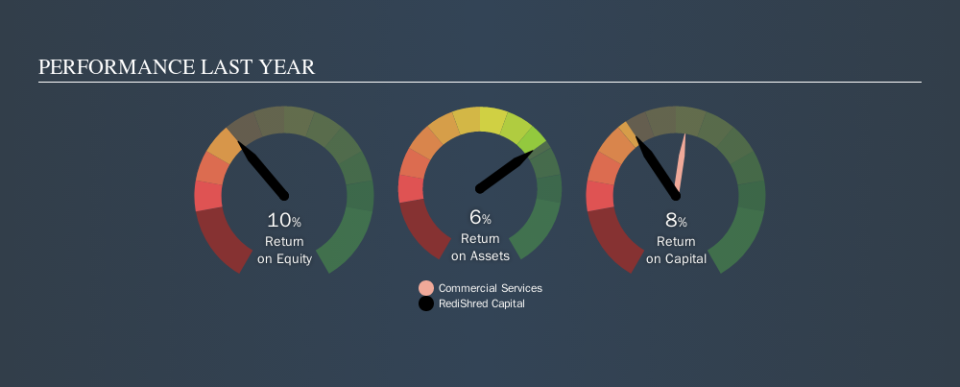Does RediShred Capital Corp. (CVE:KUT) Create Value For Shareholders?

Today we'll evaluate RediShred Capital Corp. (CVE:KUT) to determine whether it could have potential as an investment idea. Specifically, we'll consider its Return On Capital Employed (ROCE), since that will give us an insight into how efficiently the business can generate profits from the capital it requires.
First up, we'll look at what ROCE is and how we calculate it. Next, we'll compare it to others in its industry. Last but not least, we'll look at what impact its current liabilities have on its ROCE.
Understanding Return On Capital Employed (ROCE)
ROCE is a measure of a company's yearly pre-tax profit (its return), relative to the capital employed in the business. Generally speaking a higher ROCE is better. In brief, it is a useful tool, but it is not without drawbacks. Author Edwin Whiting says to be careful when comparing the ROCE of different businesses, since 'No two businesses are exactly alike.
So, How Do We Calculate ROCE?
The formula for calculating the return on capital employed is:
Return on Capital Employed = Earnings Before Interest and Tax (EBIT) ÷ (Total Assets - Current Liabilities)
Or for RediShred Capital:
0.079 = CA$2.5m ÷ (CA$37m - CA$5.9m) (Based on the trailing twelve months to June 2019.)
So, RediShred Capital has an ROCE of 7.9%.
View our latest analysis for RediShred Capital
Is RediShred Capital's ROCE Good?
ROCE is commonly used for comparing the performance of similar businesses. We can see RediShred Capital's ROCE is around the 7.9% average reported by the Commercial Services industry. Aside from the industry comparison, RediShred Capital's ROCE is mediocre in absolute terms, considering the risk of investing in stocks versus the safety of a bank account. It is possible that there are more rewarding investments out there.
RediShred Capital's current ROCE of 7.9% is lower than 3 years ago, when the company reported a 13% ROCE. Therefore we wonder if the company is facing new headwinds. The image below shows how RediShred Capital's ROCE compares to its industry, and you can click it to see more detail on its past growth.
When considering ROCE, bear in mind that it reflects the past and does not necessarily predict the future. ROCE can be misleading for companies in cyclical industries, with returns looking impressive during the boom times, but very weak during the busts. This is because ROCE only looks at one year, instead of considering returns across a whole cycle. Since the future is so important for investors, you should check out our free report on analyst forecasts for RediShred Capital.
What Are Current Liabilities, And How Do They Affect RediShred Capital's ROCE?
Short term (or current) liabilities, are things like supplier invoices, overdrafts, or tax bills that need to be paid within 12 months. Due to the way ROCE is calculated, a high level of current liabilities makes a company look as though it has less capital employed, and thus can (sometimes unfairly) boost the ROCE. To counter this, investors can check if a company has high current liabilities relative to total assets.
RediShred Capital has total liabilities of CA$5.9m and total assets of CA$37m. As a result, its current liabilities are equal to approximately 16% of its total assets. This is a modest level of current liabilities, which would only have a small effect on ROCE.
The Bottom Line On RediShred Capital's ROCE
That said, RediShred Capital's ROCE is mediocre, there may be more attractive investments around. But note: make sure you look for a great company, not just the first idea you come across. So take a peek at this free list of interesting companies with strong recent earnings growth (and a P/E ratio below 20).
If you like to buy stocks alongside management, then you might just love this free list of companies. (Hint: insiders have been buying them).
We aim to bring you long-term focused research analysis driven by fundamental data. Note that our analysis may not factor in the latest price-sensitive company announcements or qualitative material.
If you spot an error that warrants correction, please contact the editor at editorial-team@simplywallst.com. This article by Simply Wall St is general in nature. It does not constitute a recommendation to buy or sell any stock, and does not take account of your objectives, or your financial situation. Simply Wall St has no position in the stocks mentioned. Thank you for reading.

